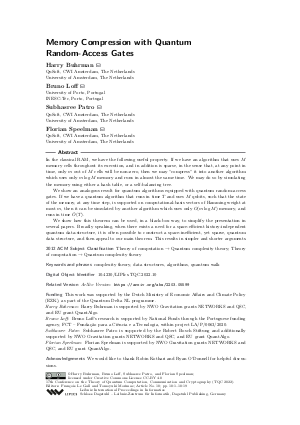@InProceedings{buhrman_et_al:LIPIcs.TQC.2022.10,
author = {Buhrman, Harry and Loff, Bruno and Patro, Subhasree and Speelman, Florian},
title = {{Memory Compression with Quantum Random-Access Gates}},
booktitle = {17th Conference on the Theory of Quantum Computation, Communication and Cryptography (TQC 2022)},
pages = {10:1--10:19},
series = {Leibniz International Proceedings in Informatics (LIPIcs)},
ISBN = {978-3-95977-237-2},
ISSN = {1868-8969},
year = {2022},
volume = {232},
editor = {Le Gall, Fran\c{c}ois and Morimae, Tomoyuki},
publisher = {Schloss Dagstuhl -- Leibniz-Zentrum f{\"u}r Informatik},
address = {Dagstuhl, Germany},
URL = {https://drops.dagstuhl.de/entities/document/10.4230/LIPIcs.TQC.2022.10},
URN = {urn:nbn:de:0030-drops-165177},
doi = {10.4230/LIPIcs.TQC.2022.10},
annote = {Keywords: complexity theory, data structures, algorithms, quantum walk}
}

 Creative Commons Attribution 4.0 International license
Creative Commons Attribution 4.0 International license


